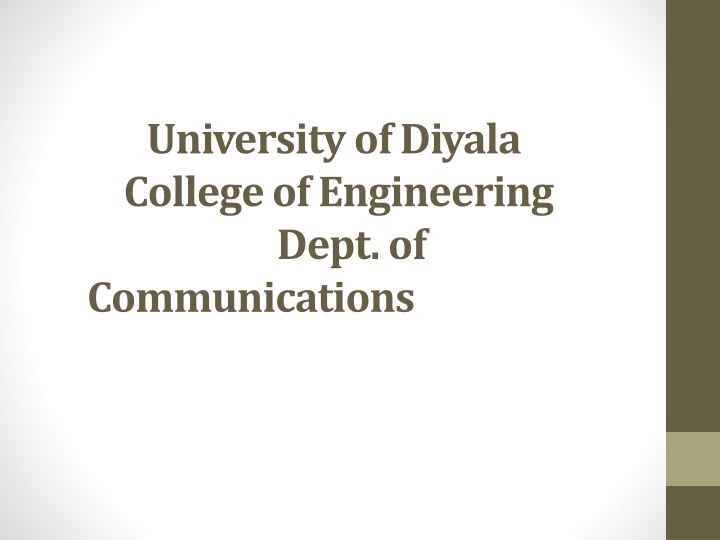
Digital Communications in Engineering Department of Diyala University
Explore the world of digital communications in the College of Engineering Department at the University of Diyala. Understand the components of a digital communication system, from source coding to channel modulation, and learn about the vital role of communication channels in transmitting signals.
Download Presentation

Please find below an Image/Link to download the presentation.
The content on the website is provided AS IS for your information and personal use only. It may not be sold, licensed, or shared on other websites without obtaining consent from the author. If you encounter any issues during the download, it is possible that the publisher has removed the file from their server.
You are allowed to download the files provided on this website for personal or commercial use, subject to the condition that they are used lawfully. All files are the property of their respective owners.
The content on the website is provided AS IS for your information and personal use only. It may not be sold, licensed, or shared on other websites without obtaining consent from the author.
E N D
Presentation Transcript
University of Diyala College of Engineering Dept. of Communications
Digital Communications By HaidarN. Al-Anbagi Lec(2) Time: (4 hrs) 2017
Elements of digital communication system: Figure 2 shows a typical digital modulation system. The data generated by the source of information could be either analog such as speech and video, or it could be digital such as computer signal. In a digital communication system, the date generated by the source of information has to be represented by a sequence of binary digits. In this binary representation, we should use as less bits as we can for the purpose of efficiency. Therefore, the lesser the bits in the binary representation, the better the efficiency of the representation will be. The other aspect we seek for in our representation is related to redundancy. The binary representation should have little or no redundancy. The process of process of converting the data generated by the source of information into binary bits is called source coding or data compression.
Next step is to pass the information sequence (binary bits generated by the source encoder) to the channel encoder. The job of the channel encoder is to introduce some redundancy in the bit stream to help the receiver overcome the noise and interferences effects. A (trivial), for example, is a form of encoding the binary information signal by repeating each digit m times, where m is a positive integer. After introducing redundancy at the channel encoder, the data is passed to the channel modulator which is the last step of processing data before sending it through the communication channel.
Therefore, we can say that digital modulator functions like an interface to the communication channel. Since all channels are capable of transmitting electrical signal (waveforms), the digital modulator mapps the binary bit stream into a signal waveform. Let us assume that the digital modulator passes each binary bit at a time, then the binary digit 0 is mapped into a waveform ?0(t) and the binary bit 1 into a waveform ?1(t). The digital modulator sends each waveform separately in a binary modulation mode. The digital modulator may also send b coded information bits by using ? = 2?distinct Each bit out of 2?possible bits, is represented by one wave form and this type of modulation is called M-ary modulation. waveforms: ??(t), i= 0,1, ., M-1.
ComunicationChannel The communication channel is the physical medium that is used to send the signal from the transmitter to the receiver. (Proakis, 2008). In case of wireless communications, the channel is the free space, while telephone channels do have variety of channels such as wire lines and optical fiber cables. No matter what kind of channel we are using in our communication system, the transmitted signal gets corrupted in a random manner. Some of the mechanisms that affect our signal are thermal noise, man-made noise, and atmospheric noise.
The Receiver At the receiver side, the first process is digital demodulator. The digital demodulator gets the corrupted signal from the channel and processes that waveform to reduce it to a sequence of numbers that represent estimates of the transmitted data. The sequence of numbers generated by digital demodulator is passed to the channel decoder which will attempt to reconstruct the original information sequence. The channel decoder uses the knowledge of the code used by the channel encoder at the redundancy contained in the received data.
Is it working well ? Now, how would I know if the combination of digital demodulation and channel decoder functions well or not? The best thing to do is to compute BER of the output of the channel decoder and see how well the combination is doing. Finally, since we need an analog output signal, the source decoder with the knowledge of source coding technique attempts to reconstruct the original data.
Another question pops up here, will the reconstructed signal be exactly the same as the original one is? The answer is No. The received signal will not be the same as the transmitted signal because of: Channel decoding errors. Possible distortion introduced by the source encoder and source decoder. Note: Depending on how much the difference between the transmitted and received signals, we would know how much distortion our digital communication system does introduce.
